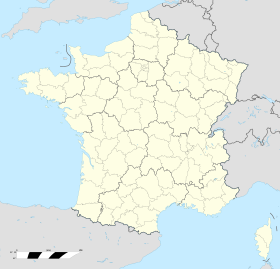Ouvrage Bambesch
| Ouvrage Bambesch | |
|---|---|
| Part of Maginot Line | |
| Northeast France | |

Bambesch Block 2
|
|
| Coordinates | 49°06′59″N 6°36′25″E / 49.11639°N 6.60694°E |
| Site information | |
| Owner | Public |
| Controlled by | France |
| Open to the public |
Yes |
| Condition | Restored |
| Site history | |
| Materials | Concrete, steel, deep excavation |
| Battles/wars | Battle of France |
| Ouvrage Bambesch | |
|---|---|
| Type of work: | Small artillery work (Petit ouvrage) |
|
sector └─sub-sector |
Fortified Sector of Faulquemont └─Steinbesch/Zimming |
| Work number: | A35 |
| Regiment: | 156th Fortress Infantry Regiment (RIF) |
| Strength: | 2 officers, 102 men |
Ouvrage Bambesch is a lesser work (petit ouvrage) of the Maginot Line. Located in the Fortified Sector of Faulquemont, the ouvrage consists of three infantry blocks, and is located between petits ouvrages Kerfent and Einseling, facing Germany. Completed in 1932, it is located in the Bois de Bambesch. On 20 June 1940 during the Battle of France, Bambesch was attacked by German forces, whose artillery battered the position, which could not be effectively supported by its neighbors, into surrender. Since 1973, Bambesch has been operated as a museum and is open to the public.
The site was surveyed by CORF (Commission d'Organisation des Régions Fortifiées), the Maginot Line's design and construction agency, and was approved for construction in October 1931. It was completed at a cost of 11 million francs by the contractor Borie of Paris. The petit ouvrage was planned for construction in two phases. The second phase was to add an 81mm mortar turret block and a separate entrance block.
Bambesch comprises three infantry blocks. The blocks are linked by deep underground galleries, which also provide space for barracks, utilities and ammunition storage. The galleries are excavated at an average depth of up to 30 metres (98 ft).
Work for the unbuilt second phase included a separate entry blocks and an 81mm mortar turret block.
In addition to the connected combat blocks, a series of detached casemates and infantry shelters surround Bambesch, including
The 1940 manning of the ouvrage under the command of Captain Pastre comprised 102 men and 2 officers of the 156th Fortress Infantry Regiment. The units were under the umbrella of both the 3rd and 4th Armies, Army Group 2. The Casernement de Zimming provided peacetime above-ground barracks and support services to Kerfent and other positions in the area.
On 20 June 1940, Bambesch was attacked by German long 88mm guns of the 167th Infantry Division. Block 2 was attacked first, driving the defenders into the underground galleries. With further attacks on Block 3, the defenders risked entrapment and asphyxiation. Despite support from neighboring Kerfent, the attackers could not be dislodged, and after two hours of bombardment, the garrison surrendered.
The fort was stabilized after the war by military engineers and was acquired by the community of Bambiderstroff in 1972, mostly to use the work's well as a municipal water supply. The site was opened to the public on 31 August 1973 by the Association des Guides de Bambesch. The fortification's machinery and equipment have been preserved.
...
Wikipedia

